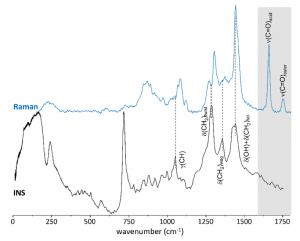Looking at the antioxidant properties of extra virgin olive oil (EVOO) using light spectroscopic tools combined with neutron spectroscopy at ISIS@MACH ITALIA Research infrastructure (IM@IT) and at ISIS Facility
Extra-virgin olive oil (EVOO) is one of the most important ingredients as well as the main source of lipids in the Mediterranean diet. It is known to contain biologically relevant phenolic components with recognised health-beneficial properties. For this reason, EVOO is defined as a functional food with high antioxidant and anti-inflammatory capacity, which is also why past studies have focused on linking olive oil consumption with a lower incidence of different cancers.
The antioxidant capabilities of EVOO depend on the structural and conformational behaviour of the phenolic components, namely phenolic acids and esters, e.g., cinnamic acid derivatives, which are predominantly determined by intra- and intermolecular H-bond interactions.
While in the past, several studies focused on the behaviours of isolated components of olive oil samples this is the first-time researchers have been able to study the real-life of the same EVOO samples from Tuscany and Umbria regions, by combining UV-VIS and Raman spectroscopies with Inelastic Neutron Scattering (INS). Light spectroscopic data were collected using the UV-VIS spectrometer at IM@IT Unit University of Rome Tor Vergata and Raman spectroscopy at the IM@IT Unit GCSI in Florence; the INS data collected using the TOSCA beamline at ISIS Facility through the IM@IT Neutron Gate.
As the major component of extra virgin olive oil is fatty acids like oleic, linoleic, and palmitic acids, it is challenging to measure the indicators of the minor phenolic compounds because they are overwhelmed by the bulk makeup and give very weak signals. However, in their study published in Antioxidants, researchers from IM@IT Research Infrastructure and the University of Coimbra worked alongside ISIS scientists to carry out INS, Raman spectroscopy and light scattering on EVOO.
Nicola Di Daniele said that “results of the analysis allow us to better understand the structure-activity relationships (SARs) underlying the beneficial activity of EVOO components and the biological activity of this dietary compound”. Piero Baglioni stressed that “INS and Raman spectroscopy have been used in the past to investigate isolated phenolic compounds, whereas in this study we have been able to collect a full characterization of the vibrational spectroscopic signal from commercially available EVOO samples by a combination of Inelastic Neutron Scattering (INS) and UV-VIS and Raman spectroscopies”. Giovanni Romanelli commented that “by using a selectively deuterated sample, the slightly structured signal from the major components in these regions could be additionally suppressed, making the analysis of the minor phenolic components easier”.
Further results of the combined study show fingerprints that allow to extract information on the quality of the EVOO in relation to some factors, related to the olive cultivar, to the position, to the soil, to the plant from which the olive originated.

This study sets a starting point for other investigations that can exploit combined optical and INS spectroscopies for the investigation of EVOO at the molecular level in more detail, by testing other parameters to further knowledge of its useful properties.
In conclusion Roberto Senesi said “the characterization of the predominant signal from major components in EVOO is a fundamental step towards the investigation of minor phenolic components through selective deuteration”.
Further information:
The full paper can be found online at DOI: https://doi.org/10.3390/antiox10050643 https://www.isis.stfc.ac.uk/Pages/SH21_olive-oil.aspx
